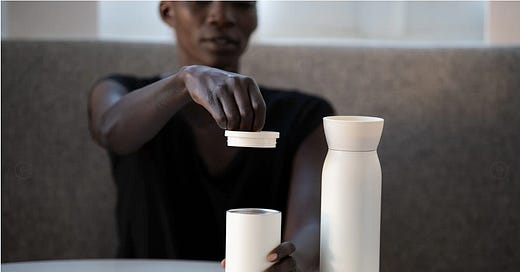“I can’t believe nobody’s doing this….”
That’s how Sky Gilbar, the founder of Remaker Labs, described his moment of inspiration for his product Hitch - the first full-size metal water bottle with a removable cup hidden inside. Supported by a hilarious video (that you can watch here), Hitch raised $1.2m on Kickstarter and $900k on Indiegogo.
What's remarkable about Hitch isn't just the innovative product itself, but the method Sky used to bring it to life. Sky, a practitioner of human-centered design and design thinking approaches to innovation, had a process with a twist. Let me walk you through it:
1. Empathy Work: Sky’s journey began with a personal pain point: “I was actually helping companies achieve their sustainability goals and I was still using single-use cups. I had a small messenger bag for my daily carry and I just didn't want to take a big, rigid cup with me anywhere. It was one thing too many to carry.” This contradiction between his values and actions sparked the idea for a sustainable alternative.
2. Market Validation: Before diving into product development, Sky validated the need with others - starting with a local coffee shop. “I just stood outside and started counting what people were carrying. Most of the people had a reusable bottle AND a single-use cup. The bottle would seem to mean that they were concerned about sustainability - and yet they were ALL carrying single-use cups. Seriously? So there was clearly some sort of convenience factor leading people to skip taking a reusable cup with them every day.” Then he started learning about paper cups - there are 300 Billion paper cups used for coffee every year and, because of the plastic lining, NONE of them can be recycled. He supplemented his observations with surveys, finding that 85% of his prospective buyers would be interested in the product.
So Sky started thinking about a reusable metal bottle that carried an insulated full-size reusable cup and cup lid inside. In design thinking, this is the problem definition phase: “How might we create a reusable metal bottle with a full-size cup inside?”
3. Comprehensive Research: Assuming a product like Hitch must already exist, Sky scoured Amazon and Alibaba. “I was just amazed that it didn’t exist. There wasn’t a solution designed around the needs of modern everyday carry. The only existing offering was your grandfather’s Stanley - and most customers coming out of Starbucks weren’t having coffee on a construction site.” This step was crucial, as it confirmed there was a gap in the market for his innovation.
4. Brainstorming and Prototyping: After working on many projects using design thinking and human centered design, Sky understood that “Sometimes you need construction paper and scissors and glue and pipe cleaners - stuff to get your hands on.” With construction paper models, he was able to explore whether the cup should attach to the outside of the bottle or disappear inside the bottle and where the cup lid might go.
5. Testing: After solving some of the big questions with construction paper models, Sky made 3d printed models and stopped people on the street to get unbiased, genuine responses. He said “You could just tell whether a particular design would work from how people were holding it, the expressions on their faces, and followup questions. The model with the cup embedded in the bottom generated the most delight.”
At this point, convinced that, as venture capitalists put it, there was a “there there”, Sky started figuring out how to make the bottle and to fund it - both of which are great stories by themselves.
While Sky’s approach employed design thinking — such as empathizing with users, defining problems, and iterative testing — he modified the process in several significant ways. Tomorrow we cover what we can learn from it.





At first I was? ... because I grew up with Thermos and their cups that screwed to the top. Then I watched the video. Ahhh ... for those who carry a water bottle AND want their coffee!! The prototyping was Brilliant. And brilliantly shared, Parker.